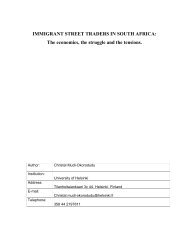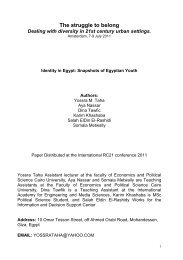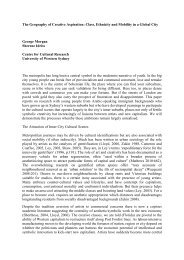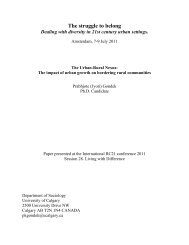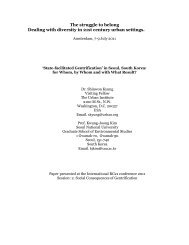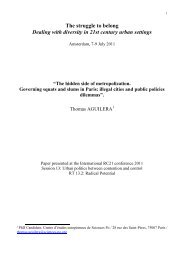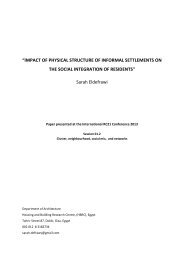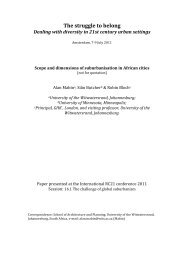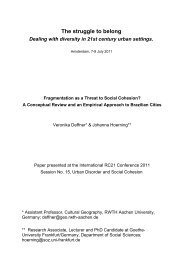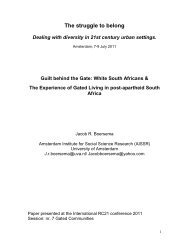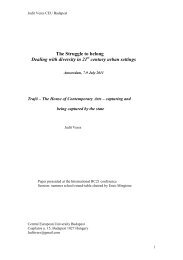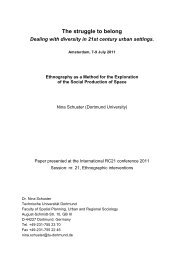Gentrification in the mill land areas of Mumbai city - RC21 ORG ...
Gentrification in the mill land areas of Mumbai city - RC21 ORG ...
Gentrification in the mill land areas of Mumbai city - RC21 ORG ...
Create successful ePaper yourself
Turn your PDF publications into a flip-book with our unique Google optimized e-Paper software.
<strong>Gentrification</strong> <strong>in</strong> <strong>the</strong> <strong>mill</strong> <strong>land</strong> <strong>areas</strong> <strong>of</strong> <strong>Mumbai</strong> City: A case study<br />
Abstract<br />
The process <strong>of</strong> gentrification started after <strong>the</strong> closure <strong>of</strong> <strong>the</strong> textile <strong>mill</strong>s <strong>in</strong> <strong>Mumbai</strong>. This<br />
paper tries to br<strong>in</strong>g out <strong>the</strong> process <strong>of</strong> gentrification that is go<strong>in</strong>g on <strong>in</strong> <strong>Mumbai</strong> with <strong>the</strong> help<br />
<strong>of</strong> a case study. The study aims to br<strong>in</strong>g out <strong>the</strong> uniqueness <strong>in</strong> <strong>the</strong> process occurr<strong>in</strong>g here and<br />
its difference from <strong>the</strong> West. It highlights <strong>the</strong> <strong>in</strong>ternal conflict, contestation and <strong>the</strong> daily<br />
negotiation with everyday life that are occurr<strong>in</strong>g <strong>in</strong> <strong>the</strong> neighbourhood. The study looks <strong>in</strong>to<br />
<strong>the</strong> formation <strong>of</strong> gated communities with<strong>in</strong> <strong>the</strong> neighbourhood and <strong>the</strong> sense <strong>of</strong> resentment<br />
and anger among <strong>the</strong> orig<strong>in</strong>al <strong>in</strong>habitants <strong>of</strong> <strong>the</strong> chawls (houses <strong>of</strong> <strong>the</strong> workers) due to <strong>the</strong><br />
<strong>in</strong>evitability <strong>of</strong> <strong>the</strong>ir eviction. The stagnation <strong>of</strong> rent <strong>in</strong> <strong>the</strong> chawls with Rent control act and<br />
its dilapidated condition, <strong>the</strong> astronomical growth <strong>of</strong> <strong>land</strong> values <strong>in</strong> <strong>the</strong> neighbourhood after<br />
<strong>the</strong> closure <strong>of</strong> <strong>the</strong> <strong>mill</strong>s, allowed <strong>the</strong> builders to take over <strong>the</strong> area for redevelopment. The<br />
mov<strong>in</strong>g <strong>in</strong> <strong>of</strong> <strong>the</strong> upper class outsiders and pay<strong>in</strong>g exorbitant rent create certa<strong>in</strong> expectations.<br />
This <strong>in</strong>hibits <strong>the</strong> barga<strong>in</strong><strong>in</strong>g capa<strong>city</strong> among <strong>the</strong> <strong>in</strong>habitants <strong>of</strong> <strong>the</strong> chawl and builders. The<br />
study tries to disentangle <strong>the</strong> complex nexus and tensions between <strong>the</strong> builders, politicians,<br />
upper class residents and chawl owners.<br />
Introduction<br />
The transformation <strong>of</strong> <strong>the</strong> <strong>city</strong> space per se is an important phenomenon <strong>in</strong> today’s world. In<br />
spite <strong>of</strong> its orig<strong>in</strong> <strong>in</strong> west, we witness <strong>city</strong> space’s shape <strong>of</strong> transformation and its gallop<strong>in</strong>g<br />
presence all over <strong>the</strong> world. The processes <strong>of</strong> rejuvenation <strong>of</strong> an underdeveloped <strong>city</strong> area not<br />
only br<strong>in</strong>g structural and functional changes but it also reshuffles <strong>the</strong> socio cultural structure<br />
<strong>of</strong> those <strong>areas</strong>. The <strong>city</strong> not only gets a makeover but it gradually turns <strong>in</strong>to a <strong>land</strong> <strong>of</strong> conflict<br />
and contestation head<strong>in</strong>g towards spatial <strong>in</strong>equality. The outcome <strong>of</strong> <strong>the</strong> <strong>city</strong> redevelopment<br />
is termed differently by different scholars by add<strong>in</strong>g some positive and negative connotations.<br />
<strong>Gentrification</strong> is one such term co<strong>in</strong>ed by urban sociologist Ruth Glass <strong>in</strong> 1964.The process is<br />
not only limited to big cities but it has gradually trickled down to <strong>the</strong> suburbs and rural <strong>areas</strong>,<br />
<strong>the</strong>reby mak<strong>in</strong>g physical alterations <strong>in</strong> <strong>the</strong> built up area, ris<strong>in</strong>g <strong>the</strong> property value and f<strong>in</strong>ally<br />
driv<strong>in</strong>g out <strong>the</strong> poor (Schaffer &Smith, 1986). Much <strong>of</strong> <strong>the</strong> studies <strong>in</strong> gentrification are based<br />
on western context where study <strong>of</strong> gentrification <strong>in</strong> <strong>the</strong> third world country like India<br />
rema<strong>in</strong>ed untouched. Thus <strong>the</strong> study <strong>of</strong> <strong>Mumbai</strong> as a site <strong>of</strong> gentrification become necessary<br />
and worth explor<strong>in</strong>g.



